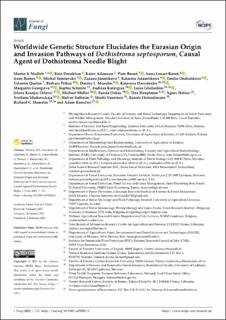| dc.contributor.author | Mullett, Martin S. | |
| dc.contributor.author | Drenkhan, Rein | |
| dc.contributor.author | Adamson, Kalev | |
| dc.contributor.author | Boroń, Piotr | |
| dc.contributor.author | Lenart-Boroń, Anna | |
| dc.contributor.author | Barnes, Irene | |
| dc.contributor.author | Tomšovský, Michal | |
| dc.contributor.author | Jánošíková, Zuzana | |
| dc.contributor.author | Adamčíková, Katarína | |
| dc.contributor.author | Ondrušková, Emília | |
| dc.contributor.author | Queloz, Valentin | |
| dc.contributor.author | Piskur, Barbara | |
| dc.contributor.author | Musolin, Dmitry L. | |
| dc.contributor.author | Davydenko, Kateryna | |
| dc.contributor.author | Georgieva, Margarita | |
| dc.contributor.author | Schmitz, Sophie | |
| dc.contributor.author | Kačergius, Audrius | |
| dc.contributor.author | Ghelardini, Luisa | |
| dc.contributor.author | Orlović, Jelena Kranjec | |
| dc.contributor.author | Müller, Michael | |
| dc.contributor.author | Oskay, Funda | |
| dc.contributor.author | Hauptman, Tine | |
| dc.contributor.author | Halász, Ágnes | |
| dc.contributor.author | Markovskaja, Svetlana | |
| dc.contributor.author | Solheim, Halvor | |
| dc.contributor.author | Vuorinen, Martti | |
| dc.contributor.author | Heinzelmann, Renate | |
| dc.contributor.author | Hamelin, Richard C. | |
| dc.contributor.author | Konečný, Adam | |
| dc.date.accessioned | 2021-10-18T10:26:43Z | |
| dc.date.available | 2021-10-18T10:26:43Z | |
| dc.date.created | 2021-03-30T17:59:46Z | |
| dc.date.issued | 2021-02-03 | |
| dc.identifier.citation | Journal of fungi (JoF). 2021, 7 (2), . | en_US |
| dc.identifier.issn | 2309-608X | |
| dc.identifier.uri | https://hdl.handle.net/11250/2823643 | |
| dc.description.abstract | Dothistroma septosporum, the primary causal agent of Dothistroma needle blight, is one of the most significant foliar pathogens of pine worldwide. Its wide host and environmental ranges have led to its global success as a pathogen and severe economic damage to pine forests in many regions. This comprehensive global population study elucidated the historical migration pathways of the pathogen to reveal the Eurasian origin of the fungus. When over 3800 isolates were examined, three major population clusters were revealed: North America, Western Europe, and Eastern Europe, with distinct subclusters in the highly diverse Eastern European cluster. Modeling of historical scenarios using approximate Bayesian computation revealed the North American cluster was derived from an ancestral population in Eurasia. The Northeastern European subcluster was shown to be ancestral to all other European clusters and subclusters. The Turkish subcluster diverged first, followed by the Central European subcluster, then the Western European cluster, which has subsequently spread to much of the Southern Hemisphere. All clusters and subclusters contained both mating-types of the fungus, indicating the potential for sexual reproduction, although asexual reproduction remained the primary mode of reproduction. The study strongly suggests the native range of D. septosporum to be in Eastern Europe (i.e., the Baltic and Western Russia) and Western Asia. | en_US |
| dc.language.iso | eng | en_US |
| dc.publisher | MDPI, Basel, Switzerland | en_US |
| dc.rights | Navngivelse 4.0 Internasjonal | * |
| dc.rights.uri | http://creativecommons.org/licenses/by/4.0/deed.no | * |
| dc.title | Worldwide Genetic Structure Elucidates the Eurasian Origin and Invasion Pathways of Dothistroma septosporum, Causal Agent of Dothistroma Needle Blight | en_US |
| dc.type | Peer reviewed | en_US |
| dc.type | Journal article | en_US |
| dc.description.version | publishedVersion | en_US |
| dc.rights.holder | © 2021 by the authors | en_US |
| dc.source.pagenumber | 28 | en_US |
| dc.source.volume | 7 | en_US |
| dc.source.journal | Journal of fungi (JoF) | en_US |
| dc.source.issue | 2 | en_US |
| dc.identifier.doi | 10.3390/jof7020111 | |
| dc.identifier.cristin | 1901762 | |
| dc.relation.project | European Regional Development Fund: CZ.02.1.01/0.0/0.0/15_003/0000453 | en_US |
| dc.source.articlenumber | 111 | en_US |
| cristin.ispublished | true | |
| cristin.fulltext | original | |
| cristin.qualitycode | 1 | |

